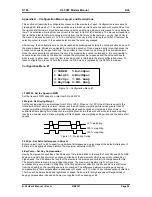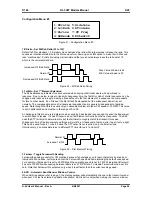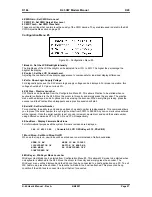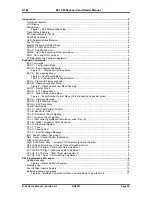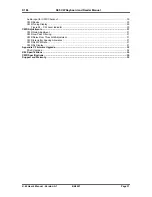
K1EL K45 CW Modem Manual K45
K-45 User’s Manual - Rev A
6/6/2021
Page 24
1:PdlTone - Sidetone Audio Control
There are many cases when the K45’s internal sidetone is not needed or wanted. Using a transceiver’s
sidetone is one example or using and external code practice oscillator is another.
2:PdlSwap - Swap Paddles
You can swap paddles with this command. It’s a nice feature to have when right- and left-handed ops want
to share the same keyer.
3:PdlMute - Paddle Enable (Muting) Control
To prevent unwanted paddle entry, the paddle entry can be turned off. When paddles are turned off the K45
will not respond to any paddle input.
4:OutPort - Modify Output Port
K45’s keying port connector can be configured in four different ways. The K45 can key one radio if PTT is
required or two if PTT is not required. In addition, the transmit output can be turned off (Mute) if you want to
use the K45 for CW practice and prevent transmitter keying. Sidetone is still active when transmit is muted.
The up/down arrows will cycle through four options which are:
1) Transmit output muted
2) Select Port 1: Tip Output = Key Ring Output = PTT
3) Select Port 1: Tip Output = Key Ring Output Off (No PTT)
4) Select Port 2: Tip Output Off
Ring Output = Key (No PTT)
Lead-in Delay
Tail Delay
PTT
Key
The letter A
Figure 20 – Lead-In and Tail Timing
5:PTT Lead - Set PTT Lead-In Delay Time (0-99)
Lead In is entered as a two-digit number which sets the delay in 10's of milliseconds.
For example, if Lead-In is set to 26 the delay will be 260 milliseconds. The maximum delay that can be set is
99 or 990 milliseconds.
6:PTT Tail - Set PTT Off Delay Time (0-99)
Specifies the delay from the end of CW transmission to PTT de-assertion it also is set in units of 10 mSecs.
7:Tune 50% - Set Keying Duty Cycle for Tune Mode
Some Ops prefer to use a 50% duty cycle when keying their transmitter for tuning purposes. This reduces
the power dissipation in the transmitter final and can contribute to a longer transmitter life.
8:KeyrType - Select Paddle Mode (applies to paddle input only)
The K45 supports six keying modes: Iambic A, Iambic B, three Ultimatic versions, and Straight key. In
Iambic and Ultimatic mode the K45 makes dits and dahs automatically based on which paddle you press. In
either Iambic mode, alternating dits and dahs are sent while both paddles are held closed. In Iambic mode
B an extra alternate dit or dah is sent if both paddles had been pressed and then released. In Ultimatic
mode, when both paddles are pressed, the keyer will send a continuous stream of whichever paddle was
last pressed. For example, if you are holding the dit paddle and then press and hold the dah paddle, the
keyer will switch from sending continuous dits to continuous dahs. In Ultimatic Dit mode, dits always take
priority while dahs take priority in Ultimatic Dah mode.
In straight key mode the K45 accepts input only on one set of contacts (see fig 14). The user enters dits and
dahs manually. The K45 will decode straight key input just like it does for paddle input. This applies to
normal sending and for Echo and QSO practice.













